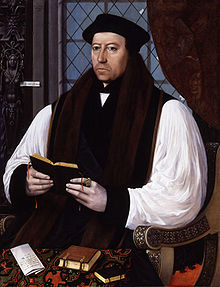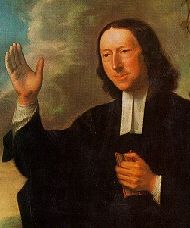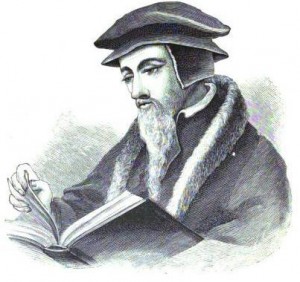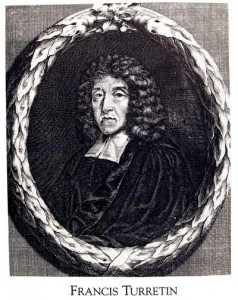By Cris D. Putnam
It is a demonstrable historical fact that every notable protestant theologian of the 16-19th century, regardless of denomination, believed and taught that the papacy was antichrist. In the British Isles, Thomas Cranmer was the Archbishop of Canterbury during the reigns of Henry VIII, Edward VI, and for a very short time for Mary I. He was successful under the former two, famously composing the Book of Common Prayer which is still in use today. Of course, his Protestant stance was what led the staunchly Catholic Queen, “bloody Mary,” to execute him. However, he was first tortured by watching his close friends being brutally executed. Under such duress, he signed a statement denying Protestantism and was scheduled to make a public profession just prior to his own execution. Instead, he recanted the coerced statement saying, “As for the Pope, I refuse him as Christ’s enemy and Antichrist, with all his false doctrines” and thus he died honorably as a reformation martyr.[1]
The Scottish reformer, John Knox, held similar views to Calvin and other reformers. He had been captured from his native land by the French and forced into slave labor until he was released to England where he served the Anglican King Edward VI. When bloody Mary ascended to the throne, he moved to Geneva where he met Calvin. Accordingly, he learned reformed theology and on his subsequent return home led the Protestant Reformation in Scotland. His writings on the papacy as antichrist are extensive. A word search of The Works of John Knox using the search terms “antichrist” and “Roman” returns an astonishing 102 occurrences in thirty-six articles. He stated, “Yea, we doubt not to prove the kingdome of the Pope to be the kingdome and power of Antichrist.”[2]Indeed, the reformers had little doubt. But is this just a Lutheran and Calvinist construct?
Lest one begin to think that this belief was particular to Calvinism, it is essential to examine the opinions of John Wesley. Of course, Wesley was Arminian in his theology and the founder of Methodism. He wrote a book entitled, Antichrist and His Ten Kingdoms, where he said of the pope, “He is in an emphatical sense, the Man of Sin…”[3] In his commentary on Revelation, he wrote, “The beast with seven heads is the Papacy of many ages: the seventh head is the man of sin, antichrist. He is a body of men from Re 13:1–17:7; he is a body of men and an individual, Re 17:8–17:11; he is an individual, Re 17:12–19:20.”[4] Wesley makes an apt observation that the biblical material points to an institution and an individual. This infers the historic/futurist hybrid interpretation mentioned earlier. It is also seen in the writings of Charles Spurgeon.
Spurgeon, the prince of preachers, wrote eloquently about the apostasy of the Church into the system of Antichrist. He also had little doubt and argued the point forcefully. For instance, in one sermon, he expounds on the clever strategy of Satan’s evil world system:
Then the world changed its tactics; it became nominally Christian, and Antichrist came forth in all its blasphemous glory. The Pope of Rome put on the triple crown, and called himself the Vicar of Christ; then came in the abomination of the worship of saints, angels, images, and pictures; then came the mass, and I know not what, of detestable error.[5]
Far from a fanciful eschatological theory relegated to the hinterland of his thought, it was demonstrably a cornerstone in his theological discourse. He was fond of elaborating on the metanarrative of salvation history as it progressed from the apostolic era. In a later sermon, he offered concerning the digression of Roman Catholic Church, “She became like the heathen around her, and began to set up the images of her saints and martyrs, till at last, after years of gradual declension, the Church of Rome ceased to be the church of Christ, and that which was once nominally the church of Christ actually became the Antichrist.”[6] Yet, it is important to note that Spurgeon also saw a future time when the Jews would return to their own land and then, “that the power of antichrist shall be utterly and eternally destroyed, and that Babylon, that is to say, the Papal system, with all its abominations, shall be cast like a millstone into the flood, to rise no more forever.”[7]
Next the views of Charles Hodge bring us into the 20th century.
[1] Christian History: Thomas Cranmer and the English Reformation., electronic ed. (Carol Stream IL: Christianity Today, 1995; Published in electronic form by Logos Research Systems, 1996).
[2] John Knox, The Works of John Knox, Serial. (Bellingham, WA: Logos Research Systems, Inc., 2003), 4:470.
[3] John Wesley, Antichrist and His Ten Kingdoms (Public Domain), 110. (See: http://www.whitehorsemedia.com/articles/?d=44.)
[4] John Wesley, Wesley’s Notes: Revelation, electronic ed. Wesley’s Notes (Albany, OR: Ages Software, 1999), Re 13:1.
[5] Charles H. Spurgeon, Spurgeon’s Sermons: Volume 10, electronic ed; Spurgeon’s Sermons (Albany, OR: Ages Software, 1998).
[6] Charles H. Spurgeon, Sermons: Volume 12.
[7] Charles H. Spurgeon, Sermons: Volume 50.










